Influence of Social Factors on Sexual Regulation in Canadian History
VerifiedAdded on 2022/09/06
|6
|1382
|20
Essay
AI Summary
This essay delves into the history of sexual regulation in Canada, tracing the evolution of laws from the inheritance of British statutes to their codification in the Criminal Code of 1892. The essay examines the significant influence of class, ethnicity, and occupation on these regulations, highlighting how women from lower social classes, particularly those involved in prostitution, faced discrimination and were targeted by law enforcement. It explores the resistance that emerged against these strict laws, including the efforts of human rights groups and sex worker rights organizations advocating for decriminalization and the right to bodily autonomy. Furthermore, the essay analyzes the various forms of coercion employed by the Canadian government to manage this resistance, including increased antagonism towards sex workers and the targeting of indigenous people. The essay concludes by emphasizing the impact of these regulations and societal attitudes on the lives of sex workers and the broader implications for human rights in Canada.
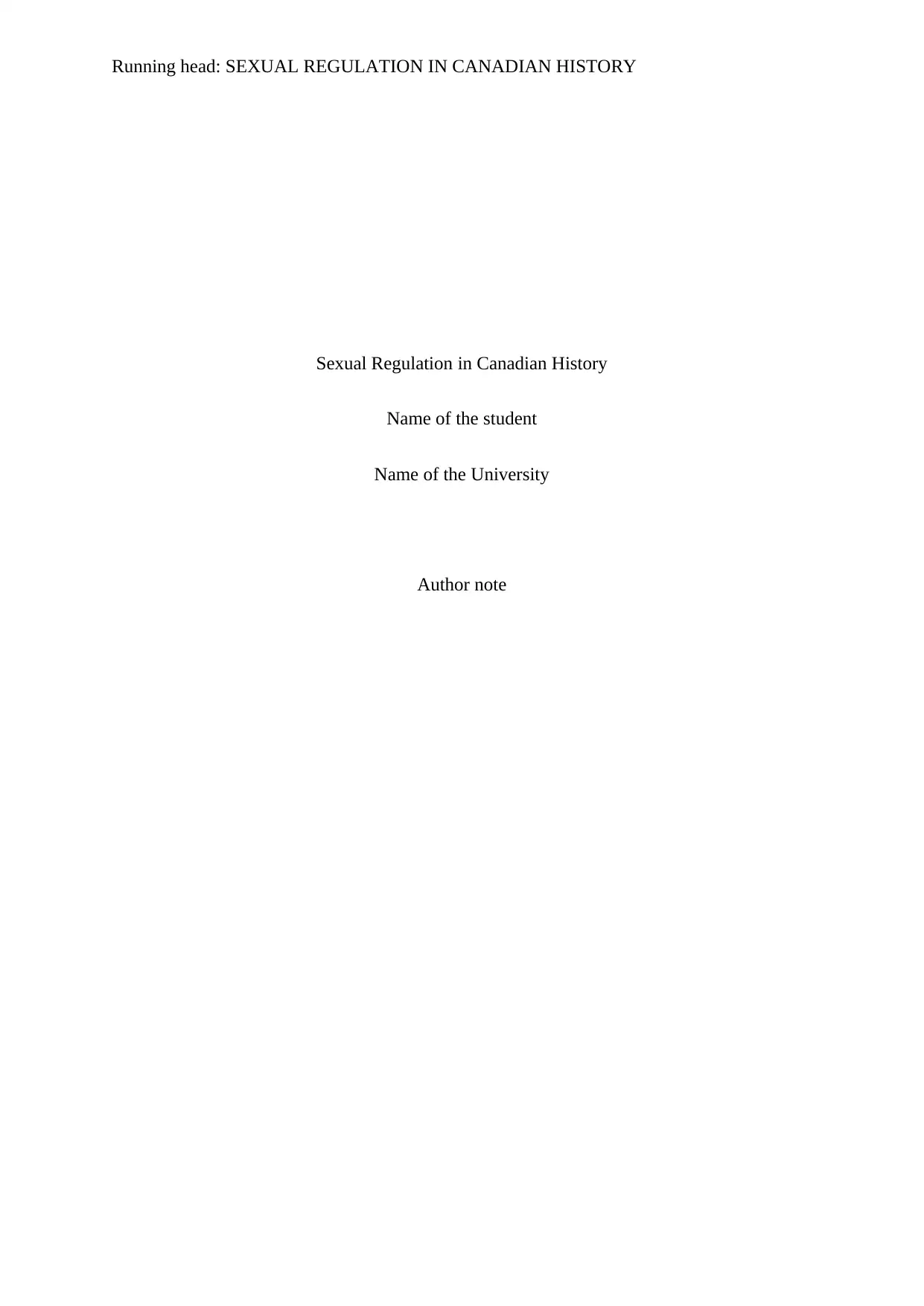
Running head: SEXUAL REGULATION IN CANADIAN HISTORY
Sexual Regulation in Canadian History
Name of the student
Name of the University
Author note
Sexual Regulation in Canadian History
Name of the student
Name of the University
Author note
Paraphrase This Document
Need a fresh take? Get an instant paraphrase of this document with our AI Paraphraser
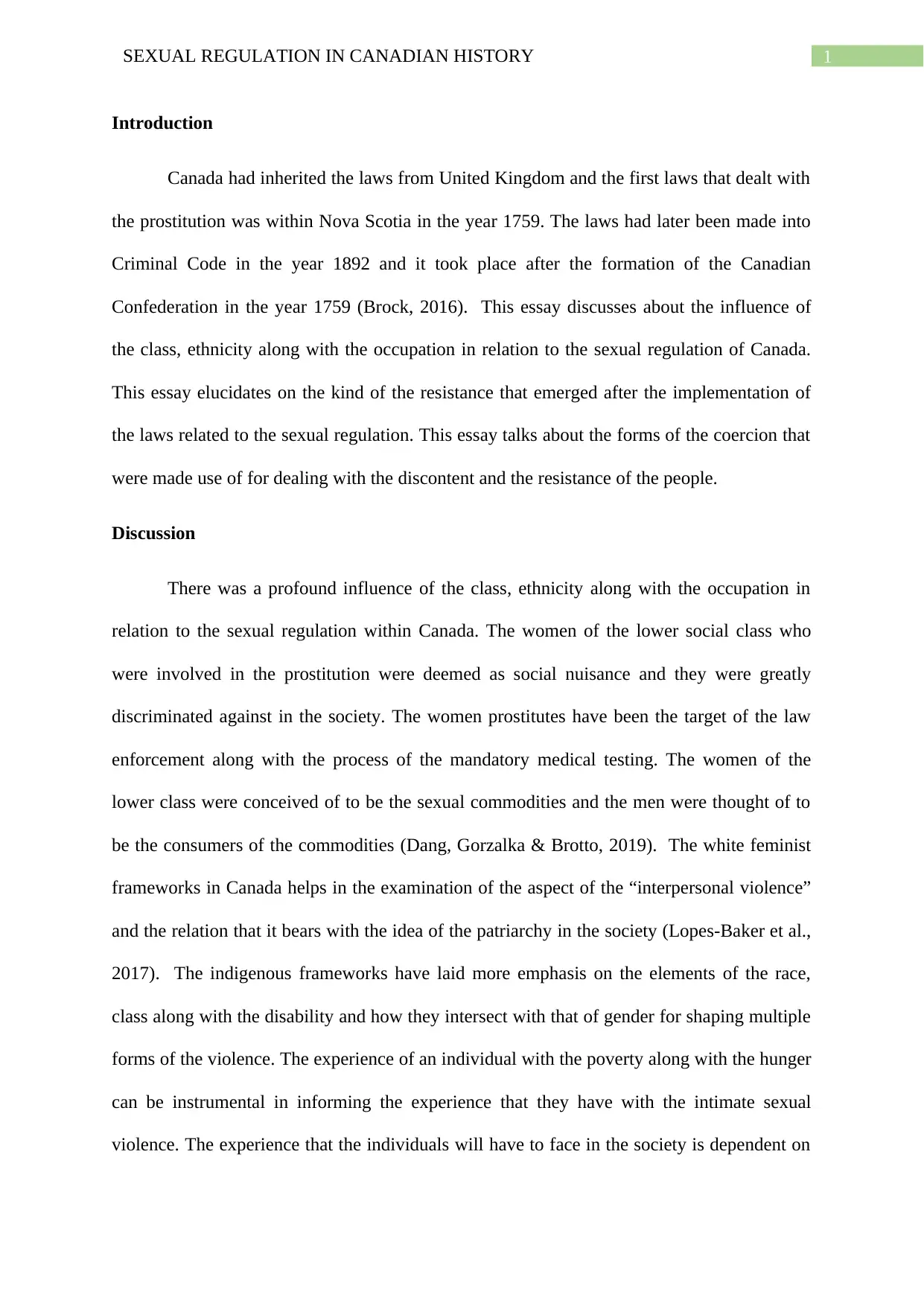
1SEXUAL REGULATION IN CANADIAN HISTORY
Introduction
Canada had inherited the laws from United Kingdom and the first laws that dealt with
the prostitution was within Nova Scotia in the year 1759. The laws had later been made into
Criminal Code in the year 1892 and it took place after the formation of the Canadian
Confederation in the year 1759 (Brock, 2016). This essay discusses about the influence of
the class, ethnicity along with the occupation in relation to the sexual regulation of Canada.
This essay elucidates on the kind of the resistance that emerged after the implementation of
the laws related to the sexual regulation. This essay talks about the forms of the coercion that
were made use of for dealing with the discontent and the resistance of the people.
Discussion
There was a profound influence of the class, ethnicity along with the occupation in
relation to the sexual regulation within Canada. The women of the lower social class who
were involved in the prostitution were deemed as social nuisance and they were greatly
discriminated against in the society. The women prostitutes have been the target of the law
enforcement along with the process of the mandatory medical testing. The women of the
lower class were conceived of to be the sexual commodities and the men were thought of to
be the consumers of the commodities (Dang, Gorzalka & Brotto, 2019). The white feminist
frameworks in Canada helps in the examination of the aspect of the “interpersonal violence”
and the relation that it bears with the idea of the patriarchy in the society (Lopes-Baker et al.,
2017). The indigenous frameworks have laid more emphasis on the elements of the race,
class along with the disability and how they intersect with that of gender for shaping multiple
forms of the violence. The experience of an individual with the poverty along with the hunger
can be instrumental in informing the experience that they have with the intimate sexual
violence. The experience that the individuals will have to face in the society is dependent on
Introduction
Canada had inherited the laws from United Kingdom and the first laws that dealt with
the prostitution was within Nova Scotia in the year 1759. The laws had later been made into
Criminal Code in the year 1892 and it took place after the formation of the Canadian
Confederation in the year 1759 (Brock, 2016). This essay discusses about the influence of
the class, ethnicity along with the occupation in relation to the sexual regulation of Canada.
This essay elucidates on the kind of the resistance that emerged after the implementation of
the laws related to the sexual regulation. This essay talks about the forms of the coercion that
were made use of for dealing with the discontent and the resistance of the people.
Discussion
There was a profound influence of the class, ethnicity along with the occupation in
relation to the sexual regulation within Canada. The women of the lower social class who
were involved in the prostitution were deemed as social nuisance and they were greatly
discriminated against in the society. The women prostitutes have been the target of the law
enforcement along with the process of the mandatory medical testing. The women of the
lower class were conceived of to be the sexual commodities and the men were thought of to
be the consumers of the commodities (Dang, Gorzalka & Brotto, 2019). The white feminist
frameworks in Canada helps in the examination of the aspect of the “interpersonal violence”
and the relation that it bears with the idea of the patriarchy in the society (Lopes-Baker et al.,
2017). The indigenous frameworks have laid more emphasis on the elements of the race,
class along with the disability and how they intersect with that of gender for shaping multiple
forms of the violence. The experience of an individual with the poverty along with the hunger
can be instrumental in informing the experience that they have with the intimate sexual
violence. The experience that the individuals will have to face in the society is dependent on
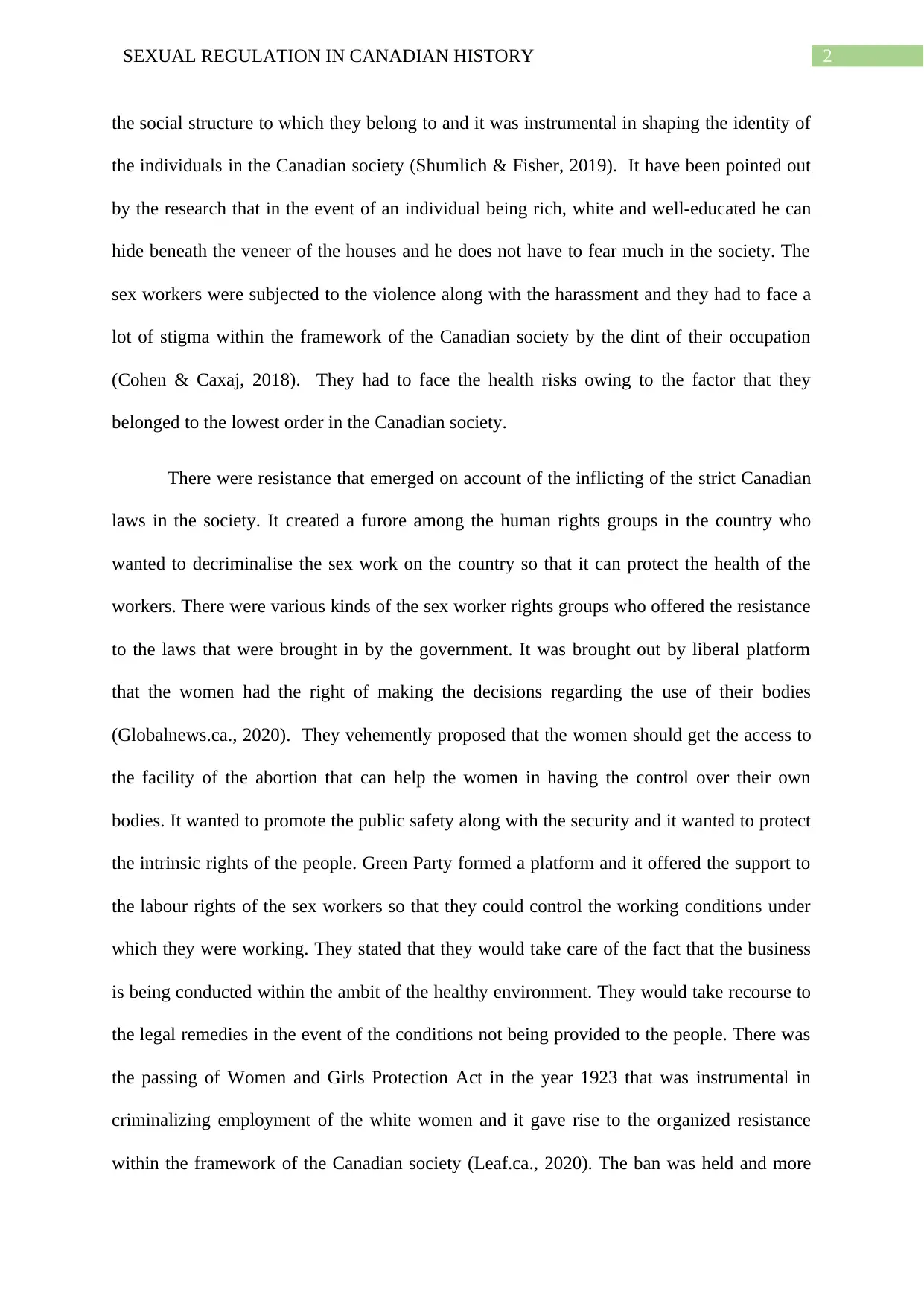
2SEXUAL REGULATION IN CANADIAN HISTORY
the social structure to which they belong to and it was instrumental in shaping the identity of
the individuals in the Canadian society (Shumlich & Fisher, 2019). It have been pointed out
by the research that in the event of an individual being rich, white and well-educated he can
hide beneath the veneer of the houses and he does not have to fear much in the society. The
sex workers were subjected to the violence along with the harassment and they had to face a
lot of stigma within the framework of the Canadian society by the dint of their occupation
(Cohen & Caxaj, 2018). They had to face the health risks owing to the factor that they
belonged to the lowest order in the Canadian society.
There were resistance that emerged on account of the inflicting of the strict Canadian
laws in the society. It created a furore among the human rights groups in the country who
wanted to decriminalise the sex work on the country so that it can protect the health of the
workers. There were various kinds of the sex worker rights groups who offered the resistance
to the laws that were brought in by the government. It was brought out by liberal platform
that the women had the right of making the decisions regarding the use of their bodies
(Globalnews.ca., 2020). They vehemently proposed that the women should get the access to
the facility of the abortion that can help the women in having the control over their own
bodies. It wanted to promote the public safety along with the security and it wanted to protect
the intrinsic rights of the people. Green Party formed a platform and it offered the support to
the labour rights of the sex workers so that they could control the working conditions under
which they were working. They stated that they would take care of the fact that the business
is being conducted within the ambit of the healthy environment. They would take recourse to
the legal remedies in the event of the conditions not being provided to the people. There was
the passing of Women and Girls Protection Act in the year 1923 that was instrumental in
criminalizing employment of the white women and it gave rise to the organized resistance
within the framework of the Canadian society (Leaf.ca., 2020). The ban was held and more
the social structure to which they belong to and it was instrumental in shaping the identity of
the individuals in the Canadian society (Shumlich & Fisher, 2019). It have been pointed out
by the research that in the event of an individual being rich, white and well-educated he can
hide beneath the veneer of the houses and he does not have to fear much in the society. The
sex workers were subjected to the violence along with the harassment and they had to face a
lot of stigma within the framework of the Canadian society by the dint of their occupation
(Cohen & Caxaj, 2018). They had to face the health risks owing to the factor that they
belonged to the lowest order in the Canadian society.
There were resistance that emerged on account of the inflicting of the strict Canadian
laws in the society. It created a furore among the human rights groups in the country who
wanted to decriminalise the sex work on the country so that it can protect the health of the
workers. There were various kinds of the sex worker rights groups who offered the resistance
to the laws that were brought in by the government. It was brought out by liberal platform
that the women had the right of making the decisions regarding the use of their bodies
(Globalnews.ca., 2020). They vehemently proposed that the women should get the access to
the facility of the abortion that can help the women in having the control over their own
bodies. It wanted to promote the public safety along with the security and it wanted to protect
the intrinsic rights of the people. Green Party formed a platform and it offered the support to
the labour rights of the sex workers so that they could control the working conditions under
which they were working. They stated that they would take care of the fact that the business
is being conducted within the ambit of the healthy environment. They would take recourse to
the legal remedies in the event of the conditions not being provided to the people. There was
the passing of Women and Girls Protection Act in the year 1923 that was instrumental in
criminalizing employment of the white women and it gave rise to the organized resistance
within the framework of the Canadian society (Leaf.ca., 2020). The ban was held and more
⊘ This is a preview!⊘
Do you want full access?
Subscribe today to unlock all pages.

Trusted by 1+ million students worldwide
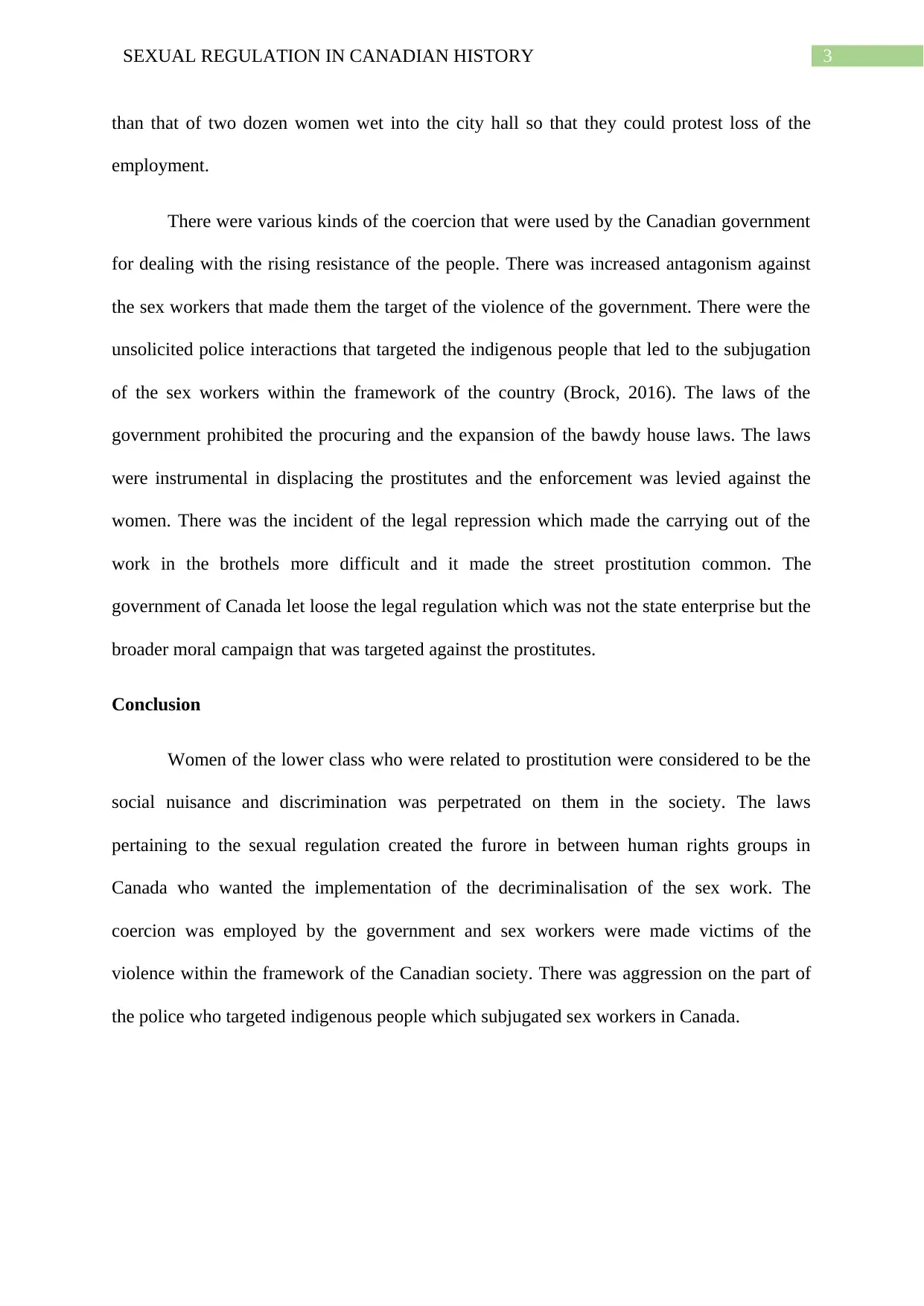
3SEXUAL REGULATION IN CANADIAN HISTORY
than that of two dozen women wet into the city hall so that they could protest loss of the
employment.
There were various kinds of the coercion that were used by the Canadian government
for dealing with the rising resistance of the people. There was increased antagonism against
the sex workers that made them the target of the violence of the government. There were the
unsolicited police interactions that targeted the indigenous people that led to the subjugation
of the sex workers within the framework of the country (Brock, 2016). The laws of the
government prohibited the procuring and the expansion of the bawdy house laws. The laws
were instrumental in displacing the prostitutes and the enforcement was levied against the
women. There was the incident of the legal repression which made the carrying out of the
work in the brothels more difficult and it made the street prostitution common. The
government of Canada let loose the legal regulation which was not the state enterprise but the
broader moral campaign that was targeted against the prostitutes.
Conclusion
Women of the lower class who were related to prostitution were considered to be the
social nuisance and discrimination was perpetrated on them in the society. The laws
pertaining to the sexual regulation created the furore in between human rights groups in
Canada who wanted the implementation of the decriminalisation of the sex work. The
coercion was employed by the government and sex workers were made victims of the
violence within the framework of the Canadian society. There was aggression on the part of
the police who targeted indigenous people which subjugated sex workers in Canada.
than that of two dozen women wet into the city hall so that they could protest loss of the
employment.
There were various kinds of the coercion that were used by the Canadian government
for dealing with the rising resistance of the people. There was increased antagonism against
the sex workers that made them the target of the violence of the government. There were the
unsolicited police interactions that targeted the indigenous people that led to the subjugation
of the sex workers within the framework of the country (Brock, 2016). The laws of the
government prohibited the procuring and the expansion of the bawdy house laws. The laws
were instrumental in displacing the prostitutes and the enforcement was levied against the
women. There was the incident of the legal repression which made the carrying out of the
work in the brothels more difficult and it made the street prostitution common. The
government of Canada let loose the legal regulation which was not the state enterprise but the
broader moral campaign that was targeted against the prostitutes.
Conclusion
Women of the lower class who were related to prostitution were considered to be the
social nuisance and discrimination was perpetrated on them in the society. The laws
pertaining to the sexual regulation created the furore in between human rights groups in
Canada who wanted the implementation of the decriminalisation of the sex work. The
coercion was employed by the government and sex workers were made victims of the
violence within the framework of the Canadian society. There was aggression on the part of
the police who targeted indigenous people which subjugated sex workers in Canada.
Paraphrase This Document
Need a fresh take? Get an instant paraphrase of this document with our AI Paraphraser
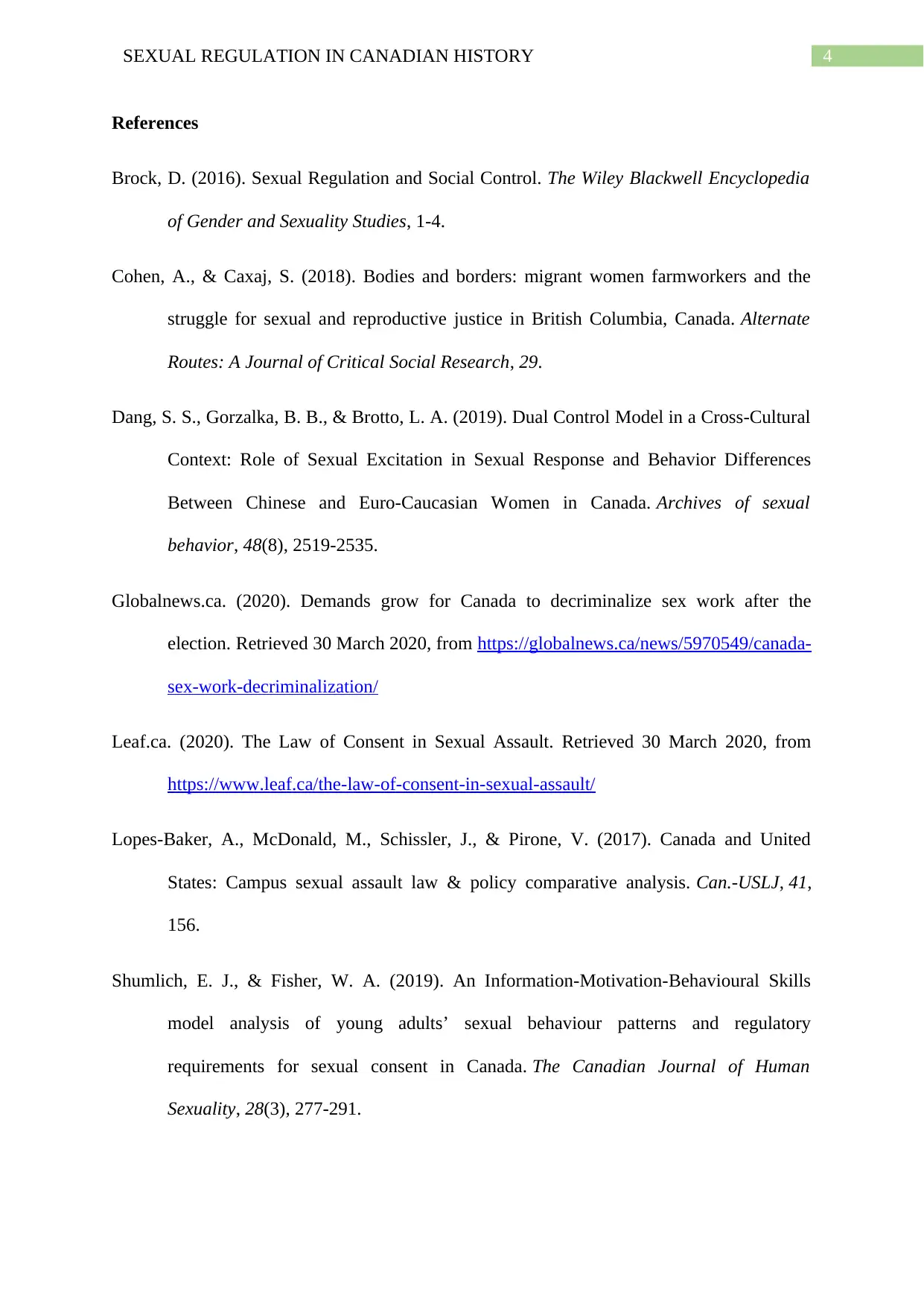
4SEXUAL REGULATION IN CANADIAN HISTORY
References
Brock, D. (2016). Sexual Regulation and Social Control. The Wiley Blackwell Encyclopedia
of Gender and Sexuality Studies, 1-4.
Cohen, A., & Caxaj, S. (2018). Bodies and borders: migrant women farmworkers and the
struggle for sexual and reproductive justice in British Columbia, Canada. Alternate
Routes: A Journal of Critical Social Research, 29.
Dang, S. S., Gorzalka, B. B., & Brotto, L. A. (2019). Dual Control Model in a Cross-Cultural
Context: Role of Sexual Excitation in Sexual Response and Behavior Differences
Between Chinese and Euro-Caucasian Women in Canada. Archives of sexual
behavior, 48(8), 2519-2535.
Globalnews.ca. (2020). Demands grow for Canada to decriminalize sex work after the
election. Retrieved 30 March 2020, from https://globalnews.ca/news/5970549/canada-
sex-work-decriminalization/
Leaf.ca. (2020). The Law of Consent in Sexual Assault. Retrieved 30 March 2020, from
https://www.leaf.ca/the-law-of-consent-in-sexual-assault/
Lopes-Baker, A., McDonald, M., Schissler, J., & Pirone, V. (2017). Canada and United
States: Campus sexual assault law & policy comparative analysis. Can.-USLJ, 41,
156.
Shumlich, E. J., & Fisher, W. A. (2019). An Information-Motivation-Behavioural Skills
model analysis of young adults’ sexual behaviour patterns and regulatory
requirements for sexual consent in Canada. The Canadian Journal of Human
Sexuality, 28(3), 277-291.
References
Brock, D. (2016). Sexual Regulation and Social Control. The Wiley Blackwell Encyclopedia
of Gender and Sexuality Studies, 1-4.
Cohen, A., & Caxaj, S. (2018). Bodies and borders: migrant women farmworkers and the
struggle for sexual and reproductive justice in British Columbia, Canada. Alternate
Routes: A Journal of Critical Social Research, 29.
Dang, S. S., Gorzalka, B. B., & Brotto, L. A. (2019). Dual Control Model in a Cross-Cultural
Context: Role of Sexual Excitation in Sexual Response and Behavior Differences
Between Chinese and Euro-Caucasian Women in Canada. Archives of sexual
behavior, 48(8), 2519-2535.
Globalnews.ca. (2020). Demands grow for Canada to decriminalize sex work after the
election. Retrieved 30 March 2020, from https://globalnews.ca/news/5970549/canada-
sex-work-decriminalization/
Leaf.ca. (2020). The Law of Consent in Sexual Assault. Retrieved 30 March 2020, from
https://www.leaf.ca/the-law-of-consent-in-sexual-assault/
Lopes-Baker, A., McDonald, M., Schissler, J., & Pirone, V. (2017). Canada and United
States: Campus sexual assault law & policy comparative analysis. Can.-USLJ, 41,
156.
Shumlich, E. J., & Fisher, W. A. (2019). An Information-Motivation-Behavioural Skills
model analysis of young adults’ sexual behaviour patterns and regulatory
requirements for sexual consent in Canada. The Canadian Journal of Human
Sexuality, 28(3), 277-291.

5SEXUAL REGULATION IN CANADIAN HISTORY
⊘ This is a preview!⊘
Do you want full access?
Subscribe today to unlock all pages.

Trusted by 1+ million students worldwide
1 out of 6
Your All-in-One AI-Powered Toolkit for Academic Success.
+13062052269
info@desklib.com
Available 24*7 on WhatsApp / Email
![[object Object]](/_next/static/media/star-bottom.7253800d.svg)
Unlock your academic potential
Copyright © 2020–2025 A2Z Services. All Rights Reserved. Developed and managed by ZUCOL.


